Transmeta die-shrinks Efficeon
Oct 5, 2004 — by LinuxDevices Staff — from the LinuxDevices Archive — 44 viewsTransmeta is aiming for higher volume and more deeply embedded markets with a die-shrink of its low-power VLIW x86-compatible processor that will clock at up to 2GHz while dissipating less than 25 watts. The 90nm Efficeon 2 targets mainstream notebook PCs, media center PCs, set top boxes and PVRs, blade servers and blade PCs, and handhelds. The company also hopes to license the technology for use in SoC (system-on-chip) cores, it says.
 According to Transmeta, the Efficeon 2 is based on a 90nm process technology from Fujitsu, and uses half as much power as its 130nm predecessor, the Efficeon, when clocked at 1GHz. The company's product roadmap takes the new chip all the way up 2GHz, and a 1.6GHz part is already shipping in the Sharp PC-MP70G, an ultra-portable laptop (pictured at right) with 10.4-inch LCD that shipped in Japan on Sept. 9.
According to Transmeta, the Efficeon 2 is based on a 90nm process technology from Fujitsu, and uses half as much power as its 130nm predecessor, the Efficeon, when clocked at 1GHz. The company's product roadmap takes the new chip all the way up 2GHz, and a 1.6GHz part is already shipping in the Sharp PC-MP70G, an ultra-portable laptop (pictured at right) with 10.4-inch LCD that shipped in Japan on Sept. 9.
Transmeta's product roadmap for the Efficeon 2 calls for the following clock speeds and TDP (thermal design power) ratings:
- 1.8 – 2.0 GHz at < 25 watts
- 1.6 – 1.8 GHz at 12 watts
- 1.4 – 1.6 GHz at 7 watts
- 1.0 – 1.1 GHz at 3 watts
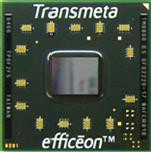
 The Efficeon 2 die is available in two packages. The TM8800 (pictured at left) measures 29 x 29mm, while the TM8820 (pictured at right) measures a scant 21 x 21mm, or 17 percent of the area required by a Pentium M/855PM combo from Intel (Transmeta's processors include an integrated Northbridge). The Efficeon 2 parts are pin-compatible with their Efficeon 1 analogs, the TM8600 and TM8620.
The Efficeon 2 die is available in two packages. The TM8800 (pictured at left) measures 29 x 29mm, while the TM8820 (pictured at right) measures a scant 21 x 21mm, or 17 percent of the area required by a Pentium M/855PM combo from Intel (Transmeta's processors include an integrated Northbridge). The Efficeon 2 parts are pin-compatible with their Efficeon 1 analogs, the TM8600 and TM8620.
Embedded versions of Transmeta's original “Crusoe” design are also available in a 21 x 21mm package.
The Efficeon 2 parts include 1MB of L2 cache, along with 128MB of L1 instruction cache and 64KB of L1 data cache. They include a 4x AGP interface, and a memory interface supporting 400MHz DDR DRAM. They also include an FPU (floating point unit), TLB (translation look-aside buffer), an integer database, LongRun2 power management hardware, and a “HyperTransport Bus” interface, which is used to connect to a supported southbridge chip at speeds claimed to be 12 times faster than a PCI bus.
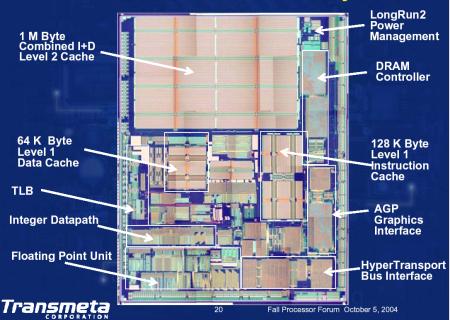
Die photo and layout — Efficeon 2
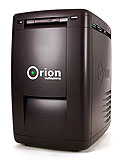 According to Transmeta, small die sizes, low power requirements, and high performance make the Efficeon ideal for “dense computing” applications such as blade servers. One company already using the Efficeon 2 is Orion Multisystems, which sells “deskside cluster workstations” such as the DS-96 (at right), which resembles a normal workstation, measuring 17 x 27 x 25 inches, and plugs into a normal wall outlet (albeit drawing up to 1500 watts), while packing the punch of up to 96 1.4GHz TM8800 processors. The DS-96, which comes with Fedora Linux (kernel 2.6.6) allegedly turns over 300 GigaFlops on the DP Linpack benchmark.
According to Transmeta, small die sizes, low power requirements, and high performance make the Efficeon ideal for “dense computing” applications such as blade servers. One company already using the Efficeon 2 is Orion Multisystems, which sells “deskside cluster workstations” such as the DS-96 (at right), which resembles a normal workstation, measuring 17 x 27 x 25 inches, and plugs into a normal wall outlet (albeit drawing up to 1500 watts), while packing the punch of up to 96 1.4GHz TM8800 processors. The DS-96, which comes with Fedora Linux (kernel 2.6.6) allegedly turns over 300 GigaFlops on the DP Linpack benchmark.
Ultra-compact applications are another area of strength for the Efficeon 2, Transmeta claims, and the company has created a “stratosphere” development board barely larger than a PCMCIA card.
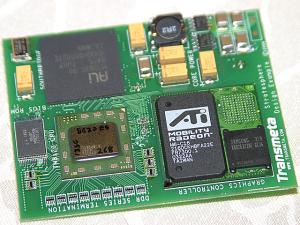
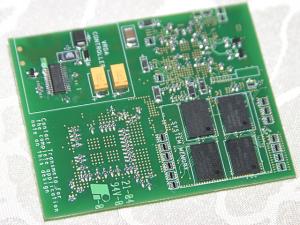
Transmeta's “Stratosphere” board, front and back
(click either to enlarge)
Additional claimed features for the Efficeon 2 include support for SSE-3, advanced video processing features, and support for an x86 extension that allows the Efficeon processor to “mark a memory location as non-executable unless it explicitly contains executable code,” Transmeta says.
Licensing
Transmeta derived about half its revenues from licensing its Long-Run power saving technology to NEC for use in SoCs, ASICs, and other semiconductor devices, in its most recently reported quarter. Licensing could become an increased focus for Transmeta if processor sales remain slow. The Register reports that Transmeta's earnings forecasts suggests “the company is expecting far lower CPU sales than before.”
This article was originally published on LinuxDevices.com and has been donated to the open source community by QuinStreet Inc. Please visit LinuxToday.com for up-to-date news and articles about Linux and open source.